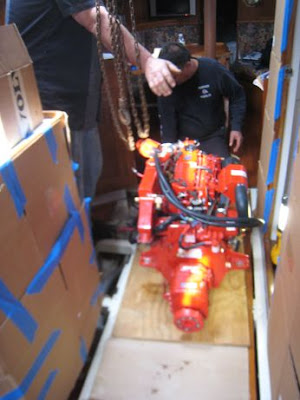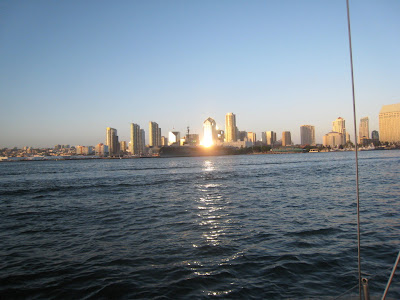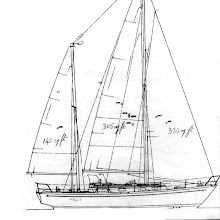Channel Islands Harbor. Not necessary a place to revisit.
Saturday the weather had been a bit overcast, but sunny in the afternoon. Sunday morning at 5:30am as I started the engine to leave Channel Islands Harbor in Oxnard the sky looked ominous. Dark clouds were on the horizon to the North and the wind was brisk inside the harbor, unusual for early morning. We backed out of our dock at 5:50am and headed for the harbor master dock. My favorite time of day, early morning, but Oxnard was not like some of the earlier ports where my companions of the morning were seals and ducks and egrets and pelicans. Channel Islands Harbor is really an overcrowded harbor with a lot of poorly maintained boats that I think are really used for floating platforms to drink beer and watch TV. Not really a place that appeals to me in the least.
The harbor master office, a very professional office here, had the red flag flying in the brisk wind, the flag that means "Small Craft Warning". Fortunately the wind was blowing us onto the harbor master dock and there were no other boats there, therefore we were able to easily get alongside and get our lines over. I was wearing my foul weather gear and anticipating some heavy weather sailing. For a brief moment I actually had a thought of staying an extra day to wait for the winds to die down, but then I realized that most of my trip had been with very little wind and what I had wanted was enough wind to actually sail! Now I had PLENTY of wind, so no time to be timid. Time to sail and sail fast! Also, I had already been in beautiful downtown Oxnard for three nights and that was more than enough. I was rested and ready to go.
At the Harbor Master office the officer on duty appeared surprised to see me so early in the morning. "You sure you want to head out into this?" he said. "Gonna be rough going out there". I assured him that I was ready to go and that I felt up to handling the weather. After all, I thought, it was really no worse than the weather that we were accustomed to in San Francisco. It is said that if one can sail in San Francisco Bay, one can sail anywhere. There is a measure of truth to that.
The officer stood up and looked out at Astraea at the pier, her flag snapping in the brisk 15-20 knot wind. "Yep," he said, "that's a perty fine rig ya got there". I agreed that she was a "fine rig" and quite up to handling the local weather.
As we headed out the breakwater at 6:20am I did have a few second thoughts as the waves were about six feet high and the frequency of just a few seconds. The wind was about 20 knots. To raise the sails one has to head into the wind, which of course normally means to head into the seas. Because of the height of the waves I put on more speed than usual and set Eloise to head us directly into the wind and seas. The waves were breaking over the bow and the wind was howling and the horizon was dark with ominous heavy clouds. I had asked for winds, and here they were! Having rounded Point Conception, however, I felt somewhat "seasoned" and confident in my ability to get the sails up and head toward Catalina. Hopefully with some good wind!
I left the cockpit with "Eloise" the auto pilot in charge of the helm. I was wearing my foul weather gear, PFD, harness, and safety harness hooked to the "jack lines", which would keep me from falling off the boat if a wave were to hit me or I was to lose my footing on the pitching deck. Due to the high waves that we were taking directly on the bow Astraea was definitely pitching. The main went up quickly with no problem, double reefed, and I carefully made my way back to the cockpit, disengaged the autopilot (Eloise), cut the throttle and headed toward Catalina. The wind was on our starboard quarter. I let out the jib and we were off under green sail power. As luck would have it, over the next couple of hours the sky brightened, the seas settled, and the wind died down to less than five knots. We had a long run to make, about 64 miles, and were going to anchor in one of the secluded coves on Catalina, which I really did not want to do after dark, therefore once again I engaged the "iron jenny" and we motor sailed through most of the day at 5-5.5 knots. I guess I used up my allotment of wind at Point Conception.
It was a quiet sail and we did not encounter another boat for the entire trip except for one rusty derelict old metal fishing boat flying a Canadian flag that refused to observe the rules of the road and forced us to jibe to miss colliding with them. They were the "give way' vessel but as they passed close ahead of us with me busy jibing to avoid hitting them the guy on the bridge came out and looked at me and shrugged. I am beginning to think that Navy ships and Astraea are the only vessels that know and observe the rules of the road. Otherwise it is just the "Law of Gross Tonnage", which means the bigger vessel has the right of way.
It was 5:00pm as we approached the anchorage at Rippers Cove on the North-East shore of Catalina Island. I had thought about continuing on South to the large recreational port of Avalon Cove. Avalon has several hundred moorings, and is a very structured port. One has to meet a harbor boat outside the harbor, be assigned a mooring, and then weave through the marine equivalent of a Wal-Mart parking lot to find one's mooring, and then use their special mooring system while people on power boats sit and sip their drinks and amuse themselves watching sailboats with their small engines and inability to back in a straight line attempt to maneuver bow and stern into position to moor properly. Being by myself and having not been in the harbor before I was more than a bit hesitant to be the evening entertainment, therefore I had decided to moor in an isolated cove. Also, I was not interested in going ashore for the facilities. There was also a huge cruise ship anchored outside the harbor, so this was probably a good idea as the harbor was more than likely packed with tourists.
Instead Astraea and I headed into a picturesque cove called Ripper's Cove. It was a small cove that offered a sand bottom (good holding) in 15-30 feet of water. It is one of the more shallow harbors on Santa Catalina and an ideal depth for us. Of course, as usual, after a day of no wind the wind began to pick up significantly about 4:00pm as we headed into the island to anchor.
If you have read of my rather frantic anchoring adventure in Cojo anchorage just south of Point Conception you will recall that in that instance where I had heavy winds and was going close to shore to get to shallow water to anchor my anchor chain fouled in the anchor locker and I had to frantically dig out my secondary anchor and anchor rode (chain and rope), rig it all up, and use it as a backup anchoring system. One of the purposes of this trip is to learn and become a better and safer sailor. This time as Eloise the auto pilot steered us toward the cove under power I dug out the secondary anchor and rigged it into the anchor holder that is attached to the bow pulpit. A very convenient place to rig the anchor. I then pulled the chain and rope anchor rode from the lazareete and flaked it out on deck in such a way that it would properly pay out if I needed to use this anchor. When I had used this anchor at the Cojo anchorage in an emergency situation (caused by my lack of proper preparation) I had discovered that I did not have a proper "swivel" on the secondary anchor. A swivel allows the anchor to stay "set", or dug in, even as the boat moves around. While in Channel Islands Harbor I had gone to West Marine (or as we sailors call it, Tiffany by the Sea) and purchased a very nice, heavy, proper swivel.
Now, as we are approaching the anchorage I had the anchor in the anchor holder, which means it was attached to the bow pulpit and hanging over the side, ready to deploy. My anchor line was properly laid out on deck. Now I needed to run the anchor line out the bow anchor guide and bring it up and attach it to the anchor. I felt a big smug in that I was going to be ready for anything this time. Just as I was attaching the anchor rode shackle to the new swivel on the anchor Astraea took a sudden and pronounced pitch and roll, all at the same time, which is not unusual with following winds and seas. You guessed it, I pitched forward against the anchor shank, which I had raised up vertically to attach the anchor line, I hit the anchor, the locking mechanism sprang open and the anchor went over the side and into the water - without the anchor line attached. Now in retrospect it is probably a good thing that I had not yet attached the anchor line as when it fell the reaction would have been to grab the line and I could have either lost the entire line and rode, gotten it tangled in the prop, or even gone over the side myself. (Not a good idea if one is holding onto an anchor). I watched rather helplessly as my expensive anchor hit the water and, of course, immediately sank in several hundred feet of water.
Plan B. I went back to the lazarette and pulled out my new and very expensive Fortress anchor, which is kept aboard for storms or conditions where I need the very most holding power. It is one of the largest of this type of anchor, Fortress, and would securely anchor a boat larger than Astraea in gale conditions. I took this anchor to the bow and, leaving it on deck, bent it onto the anchor rode. Of course my new swivel had left the boat with the anchor, so I bent on the Fortress with just a shackle, not the best way, but it works.
At about 6:00pm we were close to the shore, about 100 yards out, and I let go the main anchor, my 45 pound CQR, which is Astraea's main anchor, which has 350 feet of heavy chain attached. This time, since I had carefully prepared a second anchor, and lost my good secondary anchor and swivel over the side, the main anchor paid out perfectly and we were anchored securely in Ripper's Cove.
The cove was sheltering us somewhat from the afternoon winds; however the seas were still heavy swells from the North, most likely from a storm that was now hitting the areas up north of Point Conception. This made for a very very rough anchorage. The experience was somewhat like one of those mechanical bulls that are in the large bars like Gilley's down in Texas. Now most people ride those bulls for just a few minutes, they don't try to cook dinner, use the bathroom, and sleep on the mechanical bull. That, however, is just what I experienced this night. Now I am one who loves a gently rolling boat in an anchorage, like we experience at the moorings in Sausalito back in SF Bay. That makes me sleep well. Also, in Sausalito we would be secured to a mooring buoy where one feels very secure. A mooring buoy is securely connected to the bottom and is not normally going to drag and put one on the beach. However, as I explained earlier, this was like being on a mechanical bull. I cooked some pasta on my new Force 10 propane stove. This stove is made for sailboats and has gimbals so the stove stays "somewhat" level even as the boat rocks and rolls. I threw some sausage into the pasta and ate it in the cockpit from a bowl held securely between my legs while I watched the sun set. This was not exactly what I had pictured as I had planned for my solitary anchorage in a picturesque cove in Santa Catalina. My image had been one of quiet breezes, a gentle roll, a nice dinner and perhaps one small glass of wine, a warm breeze, and an evening watching the stars come out. Here I was huddled in foul weather gear, the wind at 15 knots, the seas at least six to eight feet, the period of the waves very short, and Astraea bucking and rolling. Add to this that my cell phone did not have a connection here. The reality of cruising was stiking home.

Ripper's Cove Santa Catalina Island. Anchored 140 yards off the beach.
My faithful Furuno watched through the night and kept track of our position off the beach as we anchored for the night. The red marks show how Astraea moved in a semicircle offshore from the anchor through the rough and windy night.
The anchor alarm was set and by 9:00pm I was confident that the anchor was holding well despite the wind and the heavy seas. I slept for an hour at a time, getting up every hour until midnight to check the anchor and the GPS. By midnight I felt secure and slept for two hours at a time, trusting my anchor was well set and my trusty anchor alarm would wake me if we moved outside our anchor circle.




















